Figure 3.

Adenylyl cyclase-cAMP signalling mediates Sema3A-induced growth cone collapse in parasympathetic neurones. (A) Inhibition of AC (DDA) prevented Sema3A-induced growth cone collapse, and stimulation of AC (FSK) caused growth cone collapse in NOS-positive parasympathetic neurones. (B) Cyclic AMP-dependent phosphodiesterase inhibition (ROL) did not augment Sema3A-induced collapse, but caused growth cone collapse by itself. (C) However, inhibition of sGC (ODQ) did not affect Sema3A-induced growth cone collapse, and stimulation of sGC (SNP) did not cause growth cone collapse. (D,E) Growth cones of parasympathetic neurones identified by VAChT-immunoreactivity (D, intact; E, collapsed). Merged images of VAChT and F-actin staining are shown in (E). Similar to NOS-positive neurones, inhibition of AC (F), but not sGC (G), prevented Sema3A-induced growth cone collapse in VAChT-positive/NOS-negative parasympathetic neurones. In addition, stimulation of AC (F), but not sGC (G), caused growth cone collapse. Tukey's test: *P < 0.05, **P < 0.01, ***P < 0.001 versus control; ##P < 0.01, ###P < 0.001 versus Sema3A (n= 3–6 for all experiments). Scale bar = 10 µm in (D) and (E). DDA, 2′,5′-dideoxyadenosine; FSK, forskolin; ODQ, 1H-[1,2,4]oxadiazole[4,3-a]quinoxalin-1-one; ROL, rolipram; Sema3A, semaphorin 3A; SNP, sodium nitroprusside; TH, tyrosine hydroxylase; VAChT, vesicular acetylcholine transporter.
